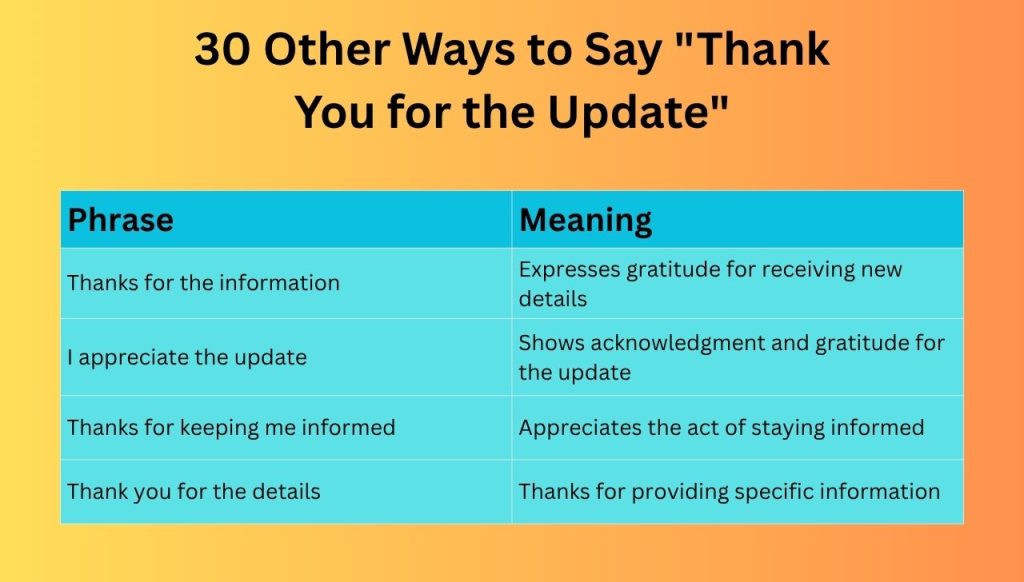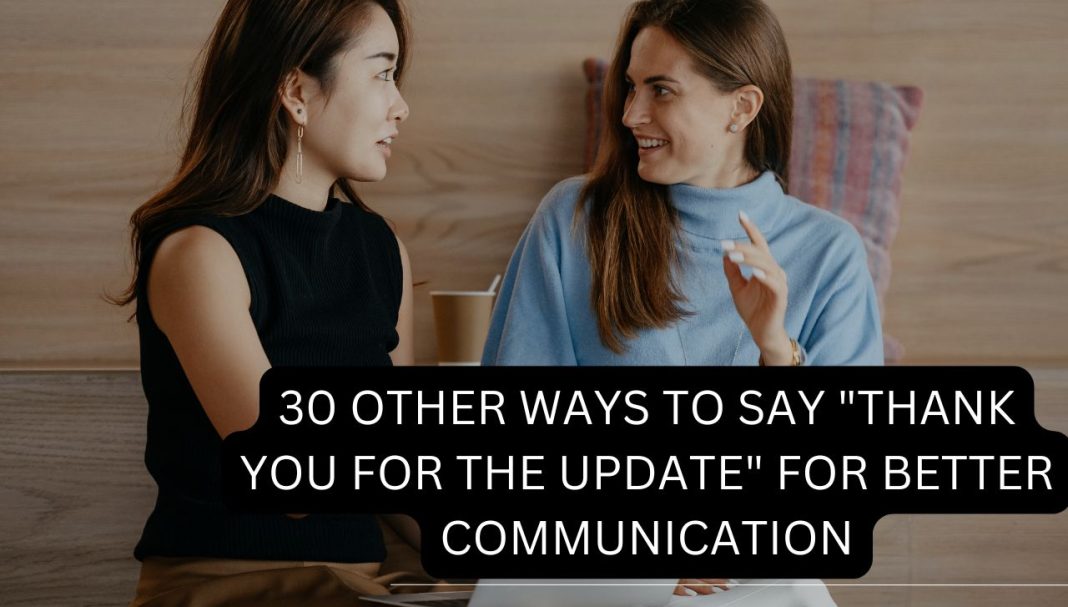“Thank you for the update” is a phrase that helps to express appreciation for the information someone has provided. Whether it’s a work-related message, a project status report, or just a friendly check-in, it’s one of the easiest ways to acknowledge someone’s effort. But it’s often used so much that it can start to feel a bit repetitive. So, how can we say it differently without losing the meaning or sound too formal? In this article, we’ll provide several alternatives, each useful in different contexts and helping you communicate more effectively.
“Thank You for the Update” Meaning
At its core, the phrase “thank you for the update” is an expression of gratitude. It acknowledges the new information you’ve received from someone, whether it’s about a project, a task, or even a situation. It lets the other person know that their effort in sharing this information is valued.
It’s not just a polite phrase; it’s a subtle sign of respect and professionalism. In work environments, for example, saying thank you for the update signals that you’re engaged and that you’re tracking the progress of ongoing matters. It makes communication smoother, fostering a sense of trust and collaboration.
Further Insights : 30 Other Ways to Say “thank you for reaching out”

When to Use “Thank You for the Update”
You’ll typically say “thank you for the update” when someone has informed you of a development, progress, or any new change in a situation. It’s common in professional settings like meetings, emails, or team collaborations.
Here are a few examples of when you’d use it:
- After receiving a status report.
- After someone informs you of changes in a project.
- When someone gives you a quick update on a task.
- After someone lets you know about changes in plans or timelines.
It can also be used informally in personal conversations where you’re getting updates from a friend or family member. But generally, it’s a phrase that’s versatile enough to cover both formal and casual situations.
Why Say “Thank You for the Update”?
Saying “thank you for the update” is more than just good manners—it helps to reinforce positive communication habits. It shows the other person that their effort to keep you informed is appreciated, which can foster trust and stronger working relationships. Additionally, in professional settings, it can help keep things efficient and organized, ensuring everyone stays on the same page.

30 Other Ways to Say “Thank You for the Update”
| Phrase | Meaning |
|---|---|
| Thanks for the information | Expresses gratitude for receiving new details |
| I appreciate the update | Shows acknowledgment and gratitude for the update |
| Thanks for keeping me informed | Appreciates the act of staying informed |
| Thank you for the details | Thanks for providing specific information |
| I appreciate the heads-up | Acknowledges early notification or warning |
| Thanks for letting me know | Grateful for being informed |
| Thanks for filling me in | Shows appreciation for receiving full details |
| I’m grateful for the update | Shows a deeper level of gratitude for the update |
| Thank you for the insight | Expresses appreciation for the information shared |
| Thanks for the news | Thanks for sharing recent developments |
| I appreciate the clarification | Grateful for clearing up any confusion |
| Thanks for the notification | Thanks for being notified about something important |
| Thanks for updating me | Acknowledging the fact that you’ve been updated |
| Thanks for the timely info | Expresses gratitude for information provided on time |
| I appreciate you keeping me posted | Shows appreciation for ongoing updates |
| Thank you for the progress report | Thanks for sharing status or progress information |
| Thanks for the quick update | Acknowledges the swift provision of information |
| I appreciate you keeping me in the loop | Thanks for including me in the information flow |
| Thanks for the follow-up | Expresses gratitude for additional communication after an event |
| Thanks for the summary | Appreciates the concise information shared |
| Thank you for the overview | Gratitude for receiving a broad perspective of the topic |
| Thanks for sharing the news | Shows appreciation for sharing important news |
| Thanks for the feedback | Acknowledges receiving responses or evaluations |
| I appreciate the communication | Thanks for keeping the lines of communication open |
| Thank you for bringing me up to speed | Grateful for getting updated or informed quickly |
| Thanks for the recent info | Shows thanks for recent information provided |
| Thank you for the details and context | Grateful for receiving detailed information with context |
| Thanks for sharing the update | Thanks for sending or conveying new information |
| I’m thankful for the update | Shows thankfulness for the update received |
| Thanks for the quick heads-up | Acknowledges an early warning or alert |
| Thank you for your time and update | Thanks for both the update and the time spent giving it |
| Thanks for the continuous updates | Shows appreciation for receiving ongoing updates |
| Thanks for the quick response | Grateful for the timely response that included updates |
Further Insights : 30 Other Ways to Say “It Has Been a Pleasure Working With You”
Conclusion
As you can see, there are numerous ways to say “thank you for the update,” each serving a different purpose depending on the tone, setting, and context. Whether you’re writing a formal email to a colleague or sending a casual text to a friend, switching up how you express gratitude can make your communication sound fresh, sincere, and more engaging. By tailoring your language to fit the situation, you’ll not only sound more professional or thoughtful but also build stronger, more positive relationships with the people you’re communicating with.

Grammar Nerd, ESL Trainer, Low-Key Comma Crusader
Daniel has taught English for over a decade, from small community classes in Oaxaca to bustling university halls in London. He has a knack for turning even the driest grammar points into relatable, real-life language tools—think fewer red pens, more real talk. He co-founded Grammation to make grammar less gatekeeper-y and more global. When he’s not decoding sentence structures, he’s probably hiking with a paperback novel or adding unnecessary hyphens for fun.
“The rules of grammar should empower people—not trip them up.”


